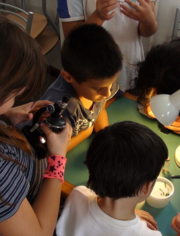The Benefits of a STEM Education [and STEAM]
In a job economy driven by rapidly changing technology, it’s more important than ever that our schools foster a love of learning. Starting our students on a steady dose of STEM curriculum in elementary primes them to become the inquisitive kiddos that lead to ambitious adults.
What does STEM stand for?
For anyone who’s seen the term STEM, but kept it on the periphery, here’s a bit of background. The acronym stands for Science, Technology, Engineering, and Math. Recently, a study of the arts was added to the educational model, making STEAM an interchangeable term you might also hear.
In school, STEM or STEAM lessons are taught using an integrative approach that shows how each subject relates to and works with the others. This interdisciplinary instruction also closely mirrors how these concept applications function in the working world.
Educational Benefits of STEM
The sooner our students are exposed to STEM activities the better. It may be scientific achievements like the first black hole picture or the fascinating technological developments. Regardless of a child’s interested in a particular subject, we know that during the elementary years a child’s synapses are most impressionable. Youngsters have an innate drive toward curiosity. STEAM programming prioritizes and encourages this curiosity, making lessons easier to internalize.
By making it accessible to anyone, STEM education benefits everyone in the classroom by:
Reducing lesson and testing anxiety
The principles of STEM diminish stress by putting the focus on the student’s ability to learn and grow, encouraging a belief in oneself.
You can even make STEM learning a daily part of a kid’s day. On this note, watches with calculators are a great option to aid kids in learning STEM by helping them practice mathematical operations, problem-solving, unit conversions, time management, data analysis, programming concepts, and financial literacy.
Making it okay to fail
Our mistakes are powerful teachers. Even STEM leaders of the past knew this. When the environment is safe and welcoming, students don’t fear punishment of failure and learn to view it as an opportunity to simply explore or try new things.
Prioritizing the 4 C’s
No matter their age, whatever their job title, they’re going to need to know how to interact well with others. STEAM helps develop the necessary 21st-century learning skills including creativity, collaboration, critical thinking, and communication.
Helping them apply meaning
STEM curriculum is engaging and motivates students to think through real world-inspired scenarios. Taught in this way, the concepts make more sense and students are able to understand the value and purpose. This depth of knowledge also leads to a greater understanding of each pillar.
STEM Career Opportunities
According to the STEM Diversity at the University of Wisconsin Madison, by 2018, it is predicted that 8.65 million STEM jobs will exist. Nevertheless, according to the U.S. Bureau of Labor Statistics, there will be a drastic shortage of almost 600,000 potential candidates for those jobs.”
So, job security is almost guaranteed, but pursuing a STEM career doesn’t necessarily mean students will automatically be chained to a MIT laboratory or relegated to Silicon Valley. STEM is everywhere, permeating just about every fathomable industry.
Contrary to some of the stereotypes, STEM-led disciplines include everything from product development for the fashion industry to healthcare careers like nurses, doctors or medical assistants, and engineers.
One of the fastest growing industries is also creating the great need for training professionals. A demand for experts in cybersecurity is growing making it a great career choice.
In short, there’s no better way to equip students for their life journey than to turn them into lifelong learners. Once they master this skill, there’s no realm, be it higher education or the real world, which they can’t conquer.
Engaging Activities to Promote STEM Learning
STEM education plays a crucial role in preparing children for the rapidly advancing technological landscape of the 21st century. To ensure that children develop a solid foundation in these fields, educators can incorporate interactive and hands-on experiences in their lessons. One effective way to promote STEM learning is through science experiments and investigations. Children can be encouraged to conduct simple experiments at home or in the classroom, exploring concepts such as magnetism, chemical reactions, or the properties of light. Through hands-on exploration, they can observe phenomena, make predictions, and draw conclusions, fostering their curiosity and analytical thinking.
Building and constructing activities are also highly engaging for children. Utilizing materials like building blocks, LEGO, or robotics kits, kids can design and build their own structures, machines, or robots. This not only enhances their creativity but also nurtures their engineering and problem-solving skills. By facing challenges and overcoming obstacles during the construction process, children learn perseverance and gain confidence in their abilities.
Incorporating technology-based activities
Technology-based activities, such as coding or programming games, can also captivate a child’s interest in STEM. There are numerous coding platforms specifically designed for kids that offer interactive and gamified learning experiences. Presenting them with challenges like designing a sustainable city, building a bridge, or creating a model of a renewable energy system can stimulate their critical thinking and encourage them to apply their knowledge to practical situations. These activities inspire creativity and innovation while fostering a sense of purpose and relevance in STEM education.
Engaging activities are vital in promoting STEM learning in children. These activities not only cultivate a deeper understanding of scientific concepts but also foster essential skills such as problem-solving, critical thinking, creativity, and collaboration. By nurturing a love for STEM at a young age, we can empower children to become confident and capable contributors to the ever-evolving world of science and technology.
STEM vs STEAM
There has been somewhat of a conflict between STEM and STEAM, wherein the latter refers to Science, Technology, Engineering, Arts and Math. Traditionalists believe that adding the “arts” to the education model for K-12 students will dilute the study of the main four pillars of STEM. Still, no one denies that getting kids excited about science at a very early age is a key to producing more STEM graduates.
Art is one element in early education that makes learning fun as they are introduced to simple STEAM activities. Linking art to science not only provides an excellent balance to academic life, but it can also encourage students to explore subjects they think are boring.
Allowing students to explore their creatively through art and combining it with science will surely produce more students interested in STEM overall, and not just in early grades. Proponents of STEAM say this is just one reason the arts are a vital part.
Perhaps even more importantly is that supporters of STEAM believe creativity is an essential part of innovation and development within the scientific world. It does not only attract young minds to love science, but it also empowers them to always think creatively and believe that anything is possible. The same is true of kids that code. Even if they do nothing relating in the field of technology, they gain so many additional benefits through the process of learning how to code.
Ways to Introduce Preschool Children to STEM
Early childhood is a critical period for development, and introducing STEM and STEAM at this stage can have a profound impact on a child’s cognitive and intellectual growth. By providing age-appropriate activities and experiences, parents ignite curiosity, foster critical thinking skills, and lay the foundation for future STEM learning.
Here are some effective ways to introduce preschool children to STEM:
Sensory Exploration
Young children learn best through hands-on experiences. Provide them with sensory activities that involve exploring varied materials, textures, and objects. For instance, they can play with water and containers to understand concepts of volume and capacity, or use sand and blocks to build structures, enhancing their understanding of basic engineering principles.
Nature Walks and Outdoor Exploration
Take children on nature walks and encourage them to observe and ask questions about the natural world. Point out different plants, animals, and their habitats. Engage them in simple experiments, like growing plants from seeds or observing the lifecycle of butterflies, to introduce basic scientific concepts.
Building and Construction Toys
Building blocks, puzzles, and construction toys are excellent tools for early STEM introduction. These toys enhance fine motor skills, spatial awareness, and problem-solving abilities. Encourage children to build towers, bridges, or simple structures, fostering an understanding of basic engineering principles.
Experimentation and Play
Incorporate simple experiments into playtime to spark curiosity and promote scientific thinking. Have children mix colors to discover how they blend, or float different objects in water to explore the concepts of buoyancy and density. Encourage them to make predictions and observe outcomes, nurturing their scientific inquiry skills.
Technology-Based Learning Tools
Introduce interactive and age-appropriate technology tools that facilitate learning. There are various STEM-oriented apps, games, and educational videos designed for young children. These resources can expose children to basic coding, problem-solving, and logical reasoning, promoting early computational thinking.
Storytelling and Books
Utilize STEM-themed storybooks to make learning engaging and enjoyable. Look for books that explore scientific concepts, engineering feats, or mathematical puzzles in a fun and accessible way. Through storytelling, children can develop language skills while expanding their understanding of STEM subjects.
Explore Creativety Through Art
As mentioned above, art is encouraged and promoted by many educators as close link to science. In this way, having kids paint a picture is one of the easiest ways to get preschool ages kids interested in all aspects of STEAM. The mixing of colors to create new ones is an excellent discussion starter about how materials mix to change into new substances.
Role-Playing and Pretend Play
Encourage children to engage in role-playing activities that involve scientific or engineering themes. Provide props like lab coats, magnifying glasses, or tools to stimulate their imagination. They can play the role of scientists, engineers, or mathematicians, fostering an early connection with STEM fields.
By incorporating these strategies, we can create a rich learning environment that cultivates curiosity, critical thinking, and a positive attitude towards STEM in very young children. Remember, keep the activities age-appropriate, hands-on, and fun, allowing children to explore and discover the wonders of the world around them while developing essential skills for their future.
AUTHOR BIO:
Dave Monaco has worked in education for 24 years and counting. He has put his M.A.T. to great use as the Head of School at Parish Episcopal School and helps Parish live out their mission to guide young people to become creative learners and bold leaders who will impact our global society. With his philosophy to “engage the mind, connect to the heart,” this father of three will continue bringing order to chaos one day at a time.










 Explore the Safe Search Engine -
Explore the Safe Search Engine -